 Hyundai Equus: Description and Operation
Second generation VI (2009–2025) / Hyundai Equus VI 2009-2025 Service Manual / Suspension System / Air Suspension System / Description and Operation
Hyundai Equus: Description and Operation
Second generation VI (2009–2025) / Hyundai Equus VI 2009-2025 Service Manual / Suspension System / Air Suspension System / Description and Operation
Second generation VI (2009–2025) / Hyundai Equus VI 2009-2025 Service Manual / Suspension System / Air Suspension System / Description and Operation
| Description |
Active type ECS is applied and it includes the self leveling
function.As shown in the picture, it consists of air spring, damper,
reservoir tank, compressor (with dryer), solenoid valve block (pressure
sensor embedded) and some other sensors.The vehicle height is controlled
electronically by air pressure generated from the compressor and the
damping force of shock absorber also is controlled independently by
solenoid valve.The air spring is another type of spring that is becoming
more popular on passenger cars, light trucks, and heavy trucks. The air
spring is a rubber cylinder, filled with compressed air. If the
vehicles level is required to change, a valve opens to add, or release
air from the air spring. An onboard compressor supplies air. Be sure
that these air springs does not function as a device to control damping
force during driving (shock absorbing effect only) but mainly controls
the vehicle height. And it offers the particularly constant level
regardless of the vehicle weight.
Leveling Control
High Level :
In order to minimize the interference between the vehicle
body and the road surface, the vehicle level is controlled by following
two features.
Manual – As long as the vehicle speed is lower than 70kph,
possible to lift from normal to high level. Opposite manual operation
(from high to normal) has no restriction for the vehicle speed.
Automatic – If the vehicle speed exceeds 70kph with high
level, it will be alternated into normal level automatically after 10sec
for the safety.
Normal Level :
This is the basic level for normal driving condition. As same as high level, there are two features.
Manual – Refer to the above ‘High level’.
Automatic – If the vehicle speed exceeds 160kph with normal
level, it will be alternated into low level after 10sec for the safety
and better fuel consumption.
Low Level :
No manual operation is supported.
Automatic – If the vehicle speed is lower than 80kph for
more than 5sec, it will be alternated into normal mode automatically,
however if it is lower than 40kph, it will be normal level immediately
regardless of the time.Whenever the level is changed, there is a time
delay between front and rear wheel for the safety. For lift, rear side
will be advanced and front side will be lifted later on. For lowering,
it is opposite.(Because of this operating sequence, there may be a noise
if the brake (AVH, EPB) is being engaged while level control)
| Operation |
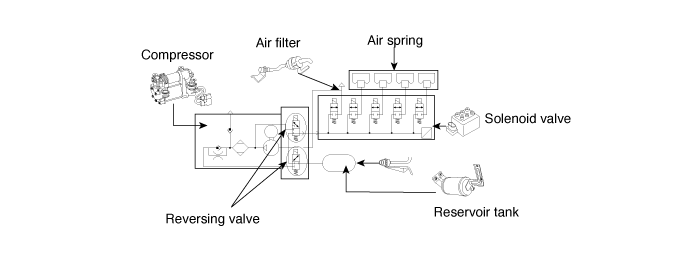
The closed loop has some merit comparing with the open loop type.
In case of open loop type, system intakes the air from
atmosphere and compresses it whenever necessary, therefore the system
response time (leveling control time) is long.
However in case of close loop type, the high pressure is
stored in the reservoir tank in ordinary time and used whenever
necessary, therefore the response time reduces dramatically. Of course
even close loop system also does intake and exhaust for the
supplementary filling of air, dryer regeneration accordingly but the
actual air amount is very low.
System Air Filling
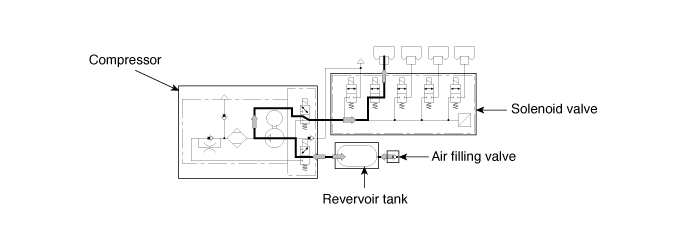
This job should be done whenever the system components were
replaced with new one (except the electrical sensor or control module).
Using air filling machine, supply the air to the air filling valve
offered in the LH side of engine room. Air will flow to reservoir tank,
compressor and will arrive in the air springs.
- Due to the length of air tube and location, at first the
front air spring is fulfilled and the rear air spring will be completed
later on.
- The vehicle has to be lifted up. (The air spring (rubber)
may be bent if the air spring was empty when the system filling starts)
- IG ON and the particular mode in the scanner are required but engine starting is not necessary.
(Refer to the section of ‘System air filling procedure’ for more detail information)
- While the system air filling, the compressor (built in vehicle) does not operate.
- There are two kinds of air filling :
System air filling: the external air pressure is supplied at
the factory or workshop (1 time) the vehicle compressor does not
operate. It is not possible to do this filling by vehicle compressor.
The overload of compressor must be avoided and furthermore, the vehicle
compressor will not operate if the air pressure (volume) is too low.
(Less than 80 ~ 120 bar-liter)Garage air filling (Supplementary
filling): whenever the supplemental air is required in the system, the
air is filled by the vehicle compressor.
Depending on the capacity and the pressure of the air filling
machine, the whole time to complete differs but mostly it takes around
50 sec.
The target air pressure level at each component is :
- Front air spring: around 7.5bar, Rear air spring: around
8.5bar, Reservoir: around 9~10bar.However, it may change with a little
amount in the case of air spring depending on the weight of vehicle
(passenger & baggage)
Lifting Level
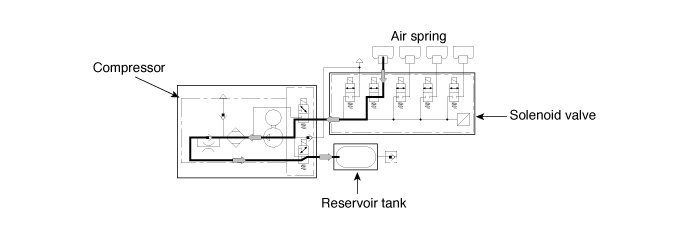
By operating the compressor, the compressed air inside
reservoir tank will be moved into the air spring via solenoid valve
block in order to lift up the vehicle height. During lifting mode, the
air does not pass the dryer as shown in the picture. The front rear
springs are lifted at first and then front springs are followed when
lift the vehicle. The reason is to reduce the air resistance while
driving and avoid giving an excessive headlamp beam to the driver in
opposite direction lane on the road for the safety.
Lowering Level

Whenever lowering the vehicle, the dryness is accomplished by
flow the air through dryer as shown in the picture. The reverse valve
and air spring valves are open so that the compressed air comes out from
the air spring. At the same time, the compressor is operated so that
the air passes through the dryer in order to store dried air into the
reservoir tank. Be sure that even during the process of lowering, the
compressor will operate in normal condition (as long as the compressor
and compressor relay is normal).
Of course, if the compressor or compressor relay is failed,
the lowering (down-leveling) is available by operating the ambient valve
(No. 7 in the picture) only like a process of ‘air discharge’ but
this is done only in case of emergency condition.
For example, the vehicle is running with high level and the
compressor (or relay) failure is detected, if the vehicle speed is
higher than 70kph for 10sec or more, the vehicle height should be
lowered to normal level by ambient valve for the safety and lower fuel
consumption.
Air Filling (Supplementary)
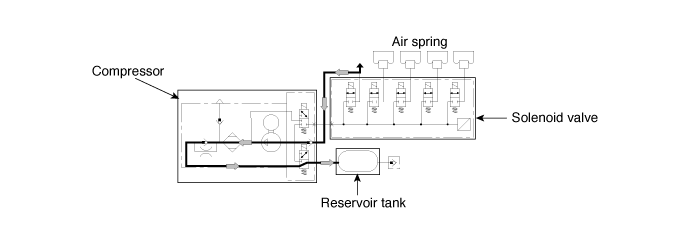
If the air mass inside the system is less than 93 bar-liter
(refer to the concept of ‘bar-liter’ in the page of ‘current
data’ in this manual), the air is added by the compressor in the
vehicle. At this time the air passes through the dryer as shown in the
picture so that the dry air can be supplied into the system. Mostly this
may happen in case of long time parking.
Air Discharge (Regeneration)
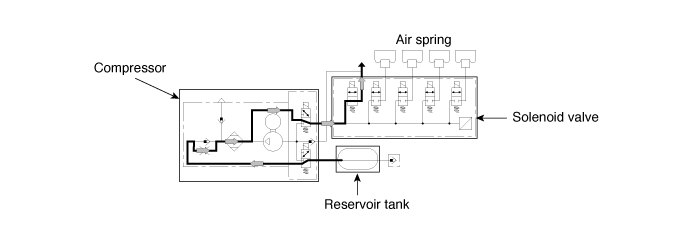
The purpose of doing air discharge is normally to regenerate
the air dryer built in the compressor. The discharged air amount is very
small.
The independent logic to perform air discharge is implemented
to decide the regeneration period based on the following factors. (Not
performed every ignition cycle)
- Air pressure sensor (built in the compressor) signal
- Height sensor signal
- Engine room temperature
Not only for dryer regeneration but also for other reason,
sometimes it is necessary to discharge the air from the system. Scanner
offers the ‘Air discharge mode’ to cope with this time, and just
enter to the above mode and perform the air discharge. Sometimes, air
discharging is required to inspect the noise from the rear chassis frame
or front suspension. Scanner will control the reverse valve and five
solenoid valves in the solenoid block in order to discharge the air
electrically.
Be sure that this menu in the scanner does not offer the discharge of air in the reservoir tank as follows.
| 1. |
From solenoid valve block to air filter (mostly air in the air springs):
The air in this area can be discharged by the scanner (electrically) |
| 2. |
Air in the reservoir cannot be discharged by electrical driving of solenoid valve in the scanner.
Instead, you can disconnect the air tube between the compressor and reservoir tank manually.
Then only the air in the tank will be discharged as long as the air in the air springs is closed by the solenoid valves.
This means that the vehicle will not be rapidly lowered even
if the mentioned tube is disconnected. However, disconnect the tube
gently because the air will come out rapidly. |
 Components and Components Location
Components and Components Location
Components Location
1. Compressor2. Air tank3. Air tube4. ECU5. Rear CDC Damper6. Rear spring7. Front air strut assembly8. G-Sensor9. Height sensor
...
 Repair procedures
Repair procedures
Air Injection Procedure
•
When injecting air into the air suspension system, always
raise the vehicle off the ground using a lift to prevent potential
damage to the ai ...
See also:
Power steering pump, belt and hoses
Check the power steering pump and hoses for leakage and damage. Replace any damaged
or leaking parts immediately. Inspect the power steering belt (or drive belt) for
evidence of cuts, cracks, exce ...
Mode Control Actuator Repair procedures
Inspection
1.
Turn the ignition switch OFF.
2.
Disconnect the mode control actuator connector.
3.
Verify that the mode control actuator operates to the defrost mode when connecting 12V to ...
Exhaust Manifold Components and Components Location
Components
1. Exhaust manifold heat protector2. Exhaust manifold3. Exhaust manifold gasket4. Exhaust manifold stay
...
Categories
Hyundai Equus Manuals
© 2011-2025 Copyright www.heqmanual.com
